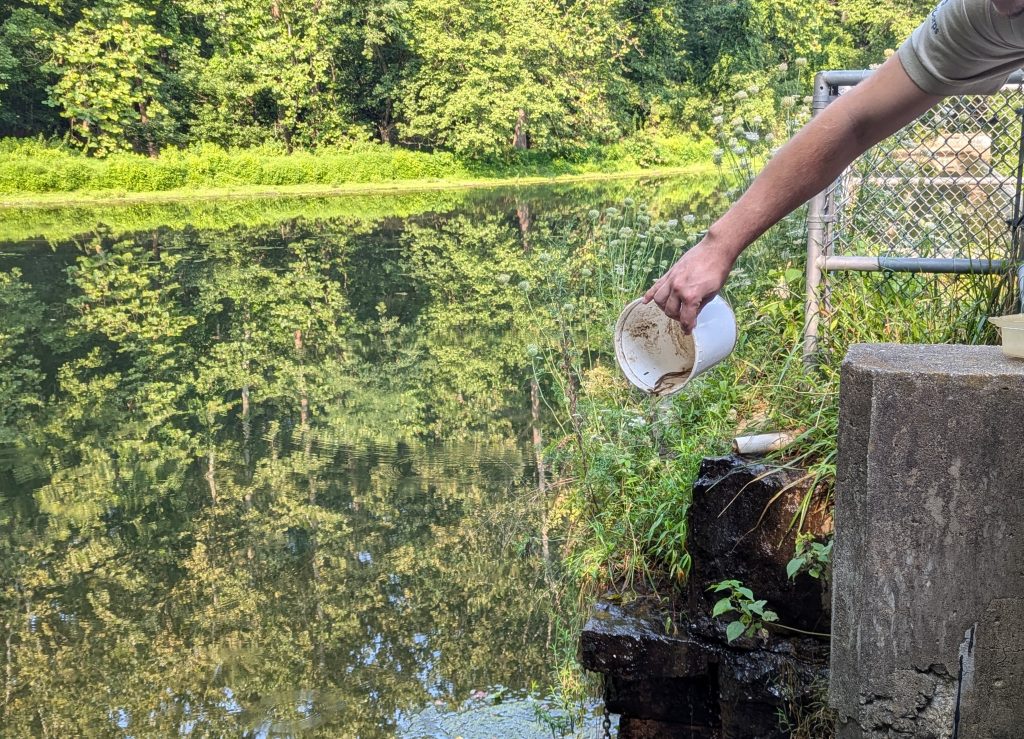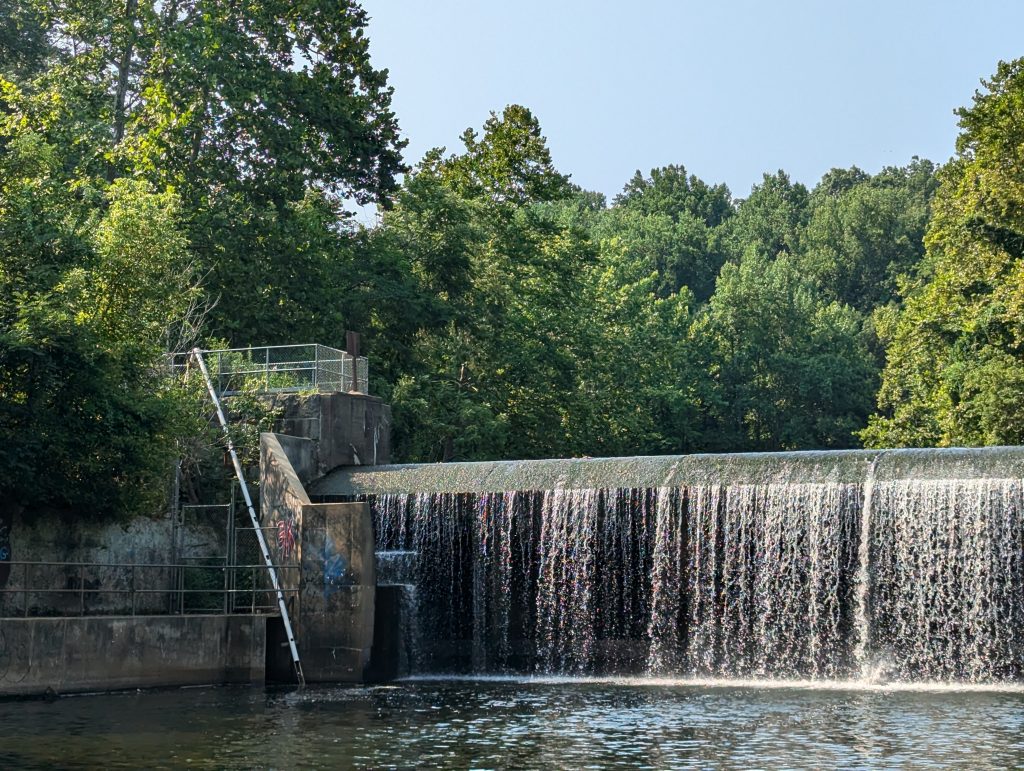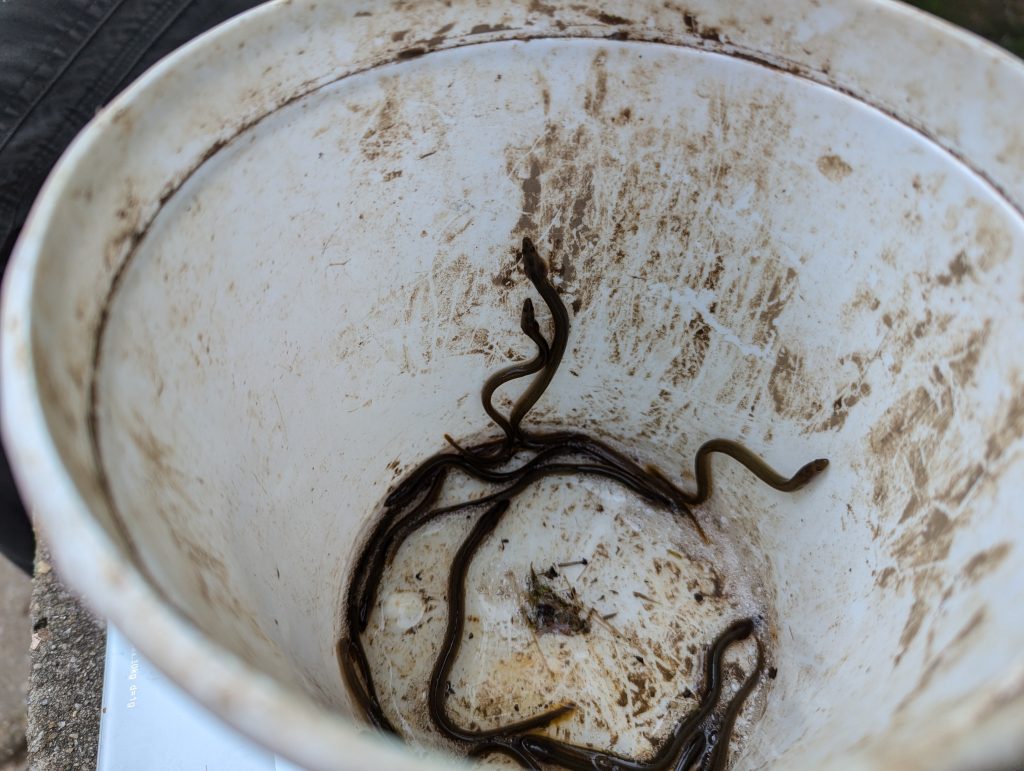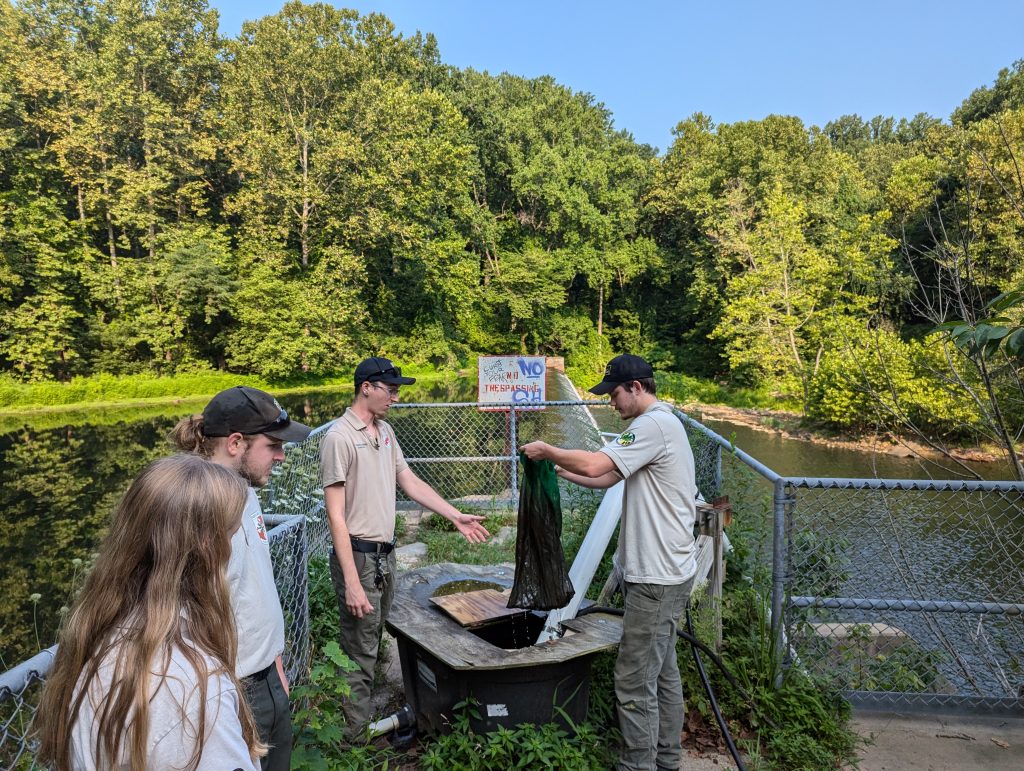One Last Hurdle: American Eels Navigate over Ellicott City’s Daniels Dam with a New Ladder
Recent dam removals on the Patapsco River ease their path

American eels get a little help from some Maryland Conservation Corps members to complete their epic migration from the Sargasso Sea. Photo by Joe Zimmermann
A thousand or so miles into their migration, some American eels find themselves in the bottom of a bucket.
One late summer day, a Maryland Conservation Corps crew took a net to the holding tank at the top of Daniels Dam on the border of Baltimore and Howard counties. Earlier this season, they had built a new eel ladder here, replacing an older structure, and throughout the migration season they continue monitoring it for new eels. By the time of this survey, the eels are a few inches long, thinner than a pencil, and eager to get upriver.
After counting and weighing the squirming mass—13 eels at a combined 18 grams—the team releases them off the upper side of the dam, where they can continue their journey for miles ahead, unimpeded by man-made obstruction.
“I’ve kind of come to love them,” Jett Clarke, an MCC member who worked at Patapsco State Park over the summer, said of the eels as they slithered away among the rocks in the riverbed. “We got to build this project, and now we see the effect it has.”
Four hundred and fifty feet of stone masonry that cuts straight across the waterway, Daniels Dam has slowed the passage of the Patapsco River a few miles from Ellicott City since the 1830s, when it powered mills for producing canvas and denim. This year, the nonprofit American Rivers began a feasibility study for the possible removal of the dam, which is now long out of use. The Department of Natural Resources, which owns and manages the dam, supported American Rivers’ application to fund the study.
In the meantime, the slippery, snakelike fish keep coming.
The eel is a strange and complex creature. They’re an often-caught and slimy inconvenience for many anglers. But American eels are a critical part of the freshwater ecosystem, a vital piece of the food web and a transportation system for freshwater mussels. Globally, several eel species are in decline or imperiled, in part because of dams that sever large areas of habitat. And because of their epic migration and mysterious life cycle, eels have also beguiled scientists and the public for hundreds of years.
One of five eel ladders in Maryland, the Daniels Dam ladder offers a chance for eels to access a vast stretch of otherwise largely inaccessible upriver habitat. But with its simple setup, the ladder could also be a model for easy eel passage with a low price tag.
A DIY solution
There’s been an eel ladder at Daniels Dam since 2014, allowing tens of thousands of eels to pass over the structure. But with the original ladder in disrepair—and the possibility that the dam won’t be here too much longer—Jim Thompson, a biologist and the fish passage coordinator for the Maryland Department of Natural Resources, saw an opportunity.
He and DNR biologist William Harbold wanted to see if a “more homemade design” could be effective. The new eel ladder cost less than $600 and is made from equipment bought at a hardware store, Thompson said. The team of MCC members put it in place in less than a day.
“If we can pass 30,000 eels in the next five years, it’s well worth the cost,” Thompson said. “Especially for the low cost of 600 bucks.”

The new eel ladder (at left) is a modest PVC pipe that spans about 43 feet up the edge of Daniels Dam. It has a few openings on the top along its length for upkeep. Photo by Joe Zimmermann
The previous ladder had already operated beyond its intended lifetime, Thompson said. Larger and made of steel cable trays, the former model also required more maintenance.
If this ladder proves successful, Thompson said it could be a model for other ladders that could be put in place at low cost and still provide substantial benefits to eels.
Eel ladders are like fish ladders, which are structures that allow fish like salmon, shad and herring to cross obstructions in the water. Because of eel biology, namely their size and climbing ability, their ladders are often less involved, allowing for more DIY solutions. American eels are powerful climbers, and some can even scale the bare face of the 27-foot-high dam, though the ladder allows for many more crossings.
Named for its function rather than its form, the eel ladder at Daniels doesn’t resemble a step ladder. It’s more of a simple tube—or a kind of eely waterslide—that stretches from the top of the dam to the water below, where it runs a few feet under the surface and provides an attraction flow that interests eels. The bottom of the pipe is covered with substrate netting that gives the eels enough purchase for their ascent.
There had been a fish ladder on the Daniels Dam as well, but it was closed after the invasive species Chesapeake Channa, or northern snakehead, were documented below the dam, Thompson said. Now, however, Channa are present both upstream and downstream, which has influenced the discussion around removing Daniels Dam.
‘The most fascinating creatures’
Eels are somewhat underappreciated in the U.S., said Alexis Park, a natural resources biologist who runs the eel monitoring program at the Department of Natural Resources. While in other parts of the world, eels are culturally iconic fish, important commodities, or even the subject of worship, Americans tend to overlook the eel in its contributions to the ecosystem and its fascinating lifecycle, she said.
American eels are a top predator in streams and food source for many species in the river ecosystem. They’re a host for the larvae of the Eastern elliptio, a freshwater mussel species. Lab studies have shown that they are the primary host for the glochidia—young mussel larvae—of this species in the Chesapeake Bay drainage basin, and older sub-adult eels help the spread of these mussels in rivers. Mussels are ecologically important for their ability to filter water and provide resources to other stream life.
Eels are also a high-value food, mainly in Asia and Europe. Maryland maintains an eel fishery, although the number of eelers, or eel harvesters, has sharply declined in recent years due to a drop in demand, Park said. The remaining fishery either exports eels or sells them as bait.
The International Union for Conservation of Nature considers the American eel endangered due to global declines, but the U.S. Fish and Wildlife has twice found that the species does not warrant protection under the Endangered Species Act. Park said eel populations in the tributaries of the Chesapeake Bay are currently at a healthy level.

Eels demonstrate their tendency to climb while waiting to be weighed. During peak migration, hundreds of eels pass through the ladder. Photo by Joe Zimmermann
Eels are catadromous fish, which means they spend most of their lives in freshwater and migrate into the ocean to spawn (unlike anadromous fish, like herring and salmon, that do the opposite). Because of this, dams and the elimination of habitat is a major factor in the coastwide decline of eels, Park said.
Keith Whiteford, who previously ran the department’s eel monitoring program, said eels are some of the “most fascinating creatures on earth” because of their unique life cycle.
Every American eel—as well as every European eel—begins its life in the Sargasso Sea, a stretch of the Atlantic Ocean east of Bermuda. Questions of their origins have long plagued scientists, and Whiteford said the mysteries around eel reproduction and population make the field both exciting and challenging.
Young eels are swept by winds and current to the rivers up and down the east coast. At each phase of the eel life cycle, the eel takes on a new name and new characteristics. Small, transparent glass eels, which can fetch $2,000 per pound to seed the aquaculture industry, grow longer and darker to become elvers, then yellow eels. (Harvest of glass eels and elvers is illegal in Maryland.) This is their resident phase, in which they’ll spend most of their lives in freshwater or estuarine environments, and after spending six to 12 years in this phase, they finally mature, becoming sexually mature silver eels, stretching 1.5 to 3 feet long.
As silver eels, they stop eating. All their energy goes to the further development of their sex organs and to power their return journey to the Sargasso Sea, where they mate and die.
Then the cycle begins again, and teaming little threads of the next generation of eels set off for rivers and streams up and down the coast, from Newfoundland to Venezuela to the creeks of Maryland backyards.
“Wherever you live in Maryland, there’s a high chance the little stream behind your house has an eel,” Whiteford said. “There are these creatures that travel thousands of miles to get there, and then they go back to the Sargasso, for a thousand-mile-plus journey again.”
The future of Patapsco eels
The former eel ladder was built at Daniels Dam several years before demolition began on the Bloede Dam in 2018, which was the only remaining dam downstream of Daniels. This allowed the eel passage numbers there to serve partially as an indicator of how the Bloede Dam removal impacted eel migration upstream.
For several years, there was a nearly tenfold increase in eels: less than 40 eels crossed the Daniels ladder each year from 2014 to 2018, followed by 53 in 2019, then 361 in 2020, 3,419 in 2021, and 36,683 in 2022. Last year saw 38,683 eels pass through the ladder.
In addition to the removal of Bloede Dam allowing for more eels to reach the Daniels Dam ladder, the 2021 closure of the fish ladder at Daniels Dam also likely contributed to the greater passage, said Harbold, the DNR biologist who worked with Thompson on the new ladder. The department doesn’t know how many eels had been using the fish ladder, and more eels likely started using the eel ladder when the other route for possible passage was shut.
So far this year, the new ladder has passed 4,500 eels. Thompson expected the number to be lower this year as eels adjust to the new design and because of the dry summer. The ladder is also smaller, and it was inoperable for part of the summer due to vandalism.
Thompson said the passage in future years will determine the effectiveness of the ladder, but he’s still glad that the homegrown model is helping thousands of eels reach more habitat.

The eel ladder ends in a holding tank, which MCC members check throughout the migration from May to October. Photo by Joe Zimmermann
In May, the National Atmospheric and Oceanic Administration awarded $1.78 million to the nonprofit American Rivers to begin exploring and planning for the possible removal of Daniels Dam. It would be the fourth dam removed on the Patapsco River, and the last major impediment to fish and eel passage.
Dam removals are becoming increasingly common in the U.S. and across the world as methods to benefit river ecosystems and reconnect habitat for fish species. Daniels Dam would be the fourth and final dam on the main stem of Patapsco to be removed. Union Dam and Simkins Dam, both downriver from Daniels, were removed in 2010 and 2011.
Though fish and eel ladders provide passage for some fish while a dam is present, it’s no comparison to the effectiveness of removing a dam entirely, Thompson said.
“You take the dam out, and you’re going to have much, much higher passage numbers,” Thompson said.
By Joe Zimmermann, science writer with the Maryland Department of Natural Resources.
